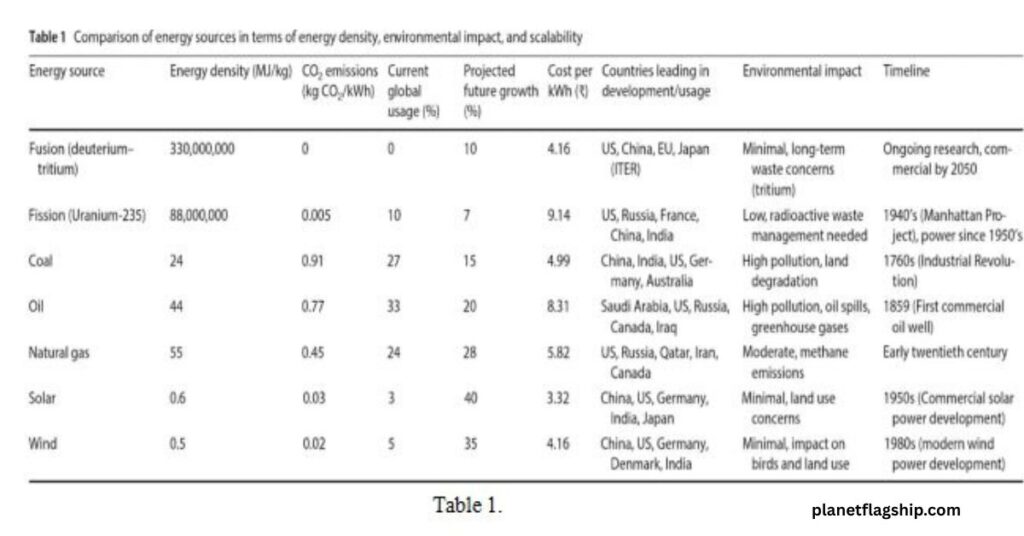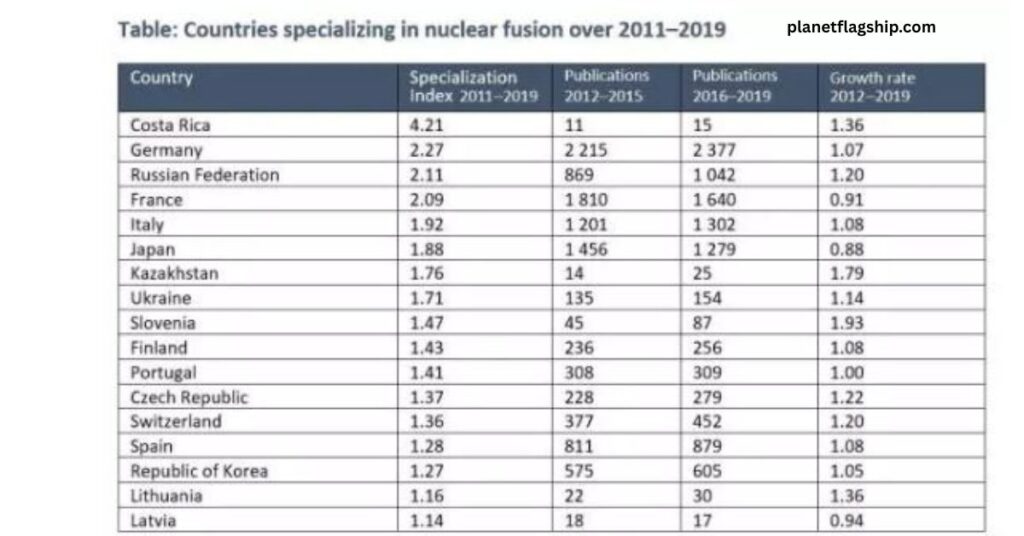Introduction
Fusion energy is often regarded as the most promising solution to global energy shortages. Application of the same process as in the Sun, fusion adds two isotopes of hydrogen to produce energy with the least environmental damage. Unlike fossil fuels, fusion does not emit any greenhouse gases, and unlike nuclear fission, it produces only small amounts of short-lived radioactive waste, making fusion a significantly safer and cleaner alternative.
The main attraction of fusion is its almost limitless fuel supply because hydrogen is abundantly present in water. Scientists have made efforts for several decades to attain usable fusion energy and have made substantial progress in technologies like magnetic confinement (tokamaks) and inertial confinement. Among the projects working on this is the ITER in France, which is attempting to prove its workability. A fusion reaction is about four million times more energetic than a chemical reaction, such as the burning of coal, oil, or gas.
Fusion Energy Generation Techniques

Magnetic Confinement: Tokamaks and Stellarators
Magnetic confinement systems employ strong magnetic fields to keep and control superheated plasma, and in doing so, they prevent it from encountering the reactor walls. One of the most advanced designs is the tokamak, a doughnut-shaped chamber that confines positively charged particles within a strong magnetic field. ITER, a global enterprise located in France, is the world’s largest project using this method, which attempts to demonstrate the possible operation of ongoing fusion reactions.
A stellarator is another type of magnetic confinement device that controls plasma using a more complex magnetic field, rather than a single magnetic field line. Compared to tokamaks, which rely on electrical current through plasma, stellarators have an advantage due to their immunity to external currents, enabling them to resist disruptions more effectively. A notable example of stellarator research is the Wendelstein 7-X in Germany, one of the most advanced projects in this field.
READ MORE: The Truth About Wildlife Tourism: Conservation Or Exploitation
Inertial Confinement Fusion (ICF)
Inertial confinement fusion is a technology that uses high-energy pulses of either laser or ion beams to compress and heat a small fuel pellet containing deuterium and tritium at a very high speed. This is a highly controlled method for simulating the extreme conditions of nuclear warheads.
In the field of nuclear energy, the National Ignition Facility (NIF) in the US achieved a significant milestone in 2022 by producing more fusion energy than the input energy required to initiate the reaction.
The Benefits of Fusion Energy

Permanent Fuel Source
The primary fuel for fusion is hydrogen isotopes, which are abundant and easily obtained from seawater. Unlike fossil fuels, which are in short supply and can be used only for a certain period of time, fusion is a renewable energy source that will be available for the length of time that humanity needs, huge amounts of forever.
Eco-Friendly Energy
One of the most significant advantages of fusion is that it produces no carbon dioxide or other greenhouse gases, making it a clean energy source that can help mitigate climate change. The radioactive waste it creates is significantly less, and it has a very short half-life compared to the long-lived radioactive waste of nuclear fission.
Improved Safety
Fusion power plants do not depend on chain reactions as fission plants do, which consequently removes the risk of huge-scale nuclear meltdown. In the event of a fusion reactor having a problem, the process would cease with no harmful effects resulting.
- Attaining and Maintaining Elevated Heat Conditions
The fusion process of nuclear reactions requires a temperature of around 100 million degrees Celsius to begin, which is significantly higher than the temperature at the center of the Sun. Inventing substances that can withstand these extreme conditions is one aspect of operational fusion reactors that remains unsolved in both science and engineering.
- Controlling Plasma Stability
Maintaining the stability of plasma within a reactor is complex. In tokamaks and stellarators, even small disruptions in the magnetic field can cause plasma to escape, halting the reaction. Researchers are continuously improving plasma confinement techniques to enhance efficiency and reliability.
- Energy Balance and Output
Currently, most fusion experiments consume more energy to initiate the reaction than they produce. The goal is to achieve a self-sustaining reaction, known as ignition, where the energy output exceeds the input. Recent progress at the NIF and advancements at ITER suggest that this breakthrough is getting closer.
- High Costs and Infrastructure Needs
Building and maintaining fusion reactors requires significant financial investment. The ITER project alone has a budget exceeding $20 billion. To make fusion energy viable on a commercial scale, costs must be reduced through technological innovation and policy support.
Recent Advances in Fusion Research

ITER and Global Tokamak Projects
ITER, currently under construction in France, is the world’s largest fusion research project, expected to begin plasma operations in the coming years. In addition, China’s EAST tokamak has achieved record-breaking plasma temperatures, contributing valuable insights to global fusion efforts.
Laser-Based Fusion Breakthroughs
In December 2022, the National Ignition Facility (NIF) achieved a major milestone by producing more energy from a fusion reaction than was initially required to trigger it. This breakthrough provided strong evidence that laser-based fusion could become a viable path toward commercial energy generation.
Growing Involvement of Private Companies
Beyond government-funded projects, private sector investment in fusion energy is increasing. Companies such as Commonwealth Fusion Systems, Helion Energy, and Tokamak Energy are developing innovative reactor designs that aim to accelerate the commercialization of fusion technology. Some startups claim they can build practical fusion power plants within the next decade.
The Road Ahead for Fusion Energy
Achieving commercial fusion power will require overcoming existing challenges while scaling up current technologies. Experts predict that the first generation of commercial fusion power plants could be operational by the 2040s or 2050s. If successful, fusion could replace fossil fuels, providing clean and limitless energy worldwide.
Government funding, international collaborations, and private sector investments are driving rapid advancements in the field. If these efforts continue, fusion energy could play a crucial role in transforming the global energy landscape and securing a sustainable future.
FAQs on Fusion Energy: The Holy Grail of Sustainable Power Generation
What is fusion energy and how does it work?
Fusion energy is produced when two light atomic nuclei, typically isotopes of hydrogen (deuterium and tritium), combine under extreme heat and pressure to form a heavier nucleus. This process releases massive amounts of energy, similar to how the Sun generates power.
How is fusion energy different from nuclear fission?
Fusion joins light atoms together, while fission splits heavy atoms apart. Unlike fission, fusion produces no long-lived radioactive waste and carries no risk of a catastrophic meltdown, making it a much safer and cleaner source of power.
Why is fusion energy considered sustainable?
Fusion uses hydrogen isotopes found abundantly in seawater, offering an almost limitless fuel supply. It emits no greenhouse gases and has minimal environmental impact, making it a powerful solution for future clean energy generation.
What are the biggest challenges in achieving fusion energy?
The main hurdles include maintaining extremely high temperatures (over 100 million°C), controlling plasma stability, achieving positive energy output, and reducing reactor costs. Projects like ITER and NIF are addressing these technical and financial challenges.
When will fusion energy become commercially available?
Experts predict that commercial fusion power could emerge by the 2040s or 2050s. With ongoing progress in research, private investment, and international cooperation, fusion is steadily moving from scientific theory to practical reality.
Conclusion
Fusion energy presents a transformative solution to the world’s increasing energy needs, offering a nearly limitless source of clean and safe power. Unlike fossil fuels, it does not contribute to climate change, and unlike nuclear fission, it generates only minimal, short-lived radioactive waste. Since the hydrogen isotopes required for fusion are abundant in seawater, this technology has the potential to provide sustainable energy for millions of years.
While fusion holds great promise, several obstacles must be overcome before it becomes a viable energy source. Achieving the extreme temperatures required for the reaction, maintaining plasma stability, and making reactors cost-effective are key challenges. However, recent progress in research, including breakthroughs in magnetic confinement, laser-driven fusion, and private-sector innovations, suggests that fusion power may be within reach.
With continued scientific advancements, increased funding, and international cooperation, fusion energy could become a reality in the coming decades. If successfully implemented, it has the potential to replace fossil fuels, reduce carbon emissions, and revolutionize global energy production. As the world moves toward cleaner and more reliable energy solutions, fusion remains a promising path toward a sustainable future.
References
Freidberg, J. P. (2008). Plasma physics and fusion energy. Cambridge University Press.
Bradshaw, A. M., Hamacher, T., & Fischer, U. (2011). Is nuclear fusion a sustainable energy form?. Fusion Engineering and Design, 86(9-11), 2770-2773.
Katoch, G., Sharma, G., Alaghbari, M., et al. Fusion energy: a sustainable pathway to meeting future global energy demands. Discov Sustain 6, 221 (2025). https://doi.org/10.1007/s43621-025-00906-6
UNESCO (2021)
UNESCO Science Report: the Race Against Time for Smarter Development
S.S. Schneegans, T. Straza, and J. Lewis (eds). UNESCO Publishing: Paris

John is a professional blogger and passionate advocate for environmental sustainability. With years of experience exploring eco-friendly practices and green innovations, he shares insightful articles on Planet Flagship to inspire a sustainable future. John’s expertise lies in making complex environmental topics accessible and actionable, empowering readers to make meaningful changes for the planet.
